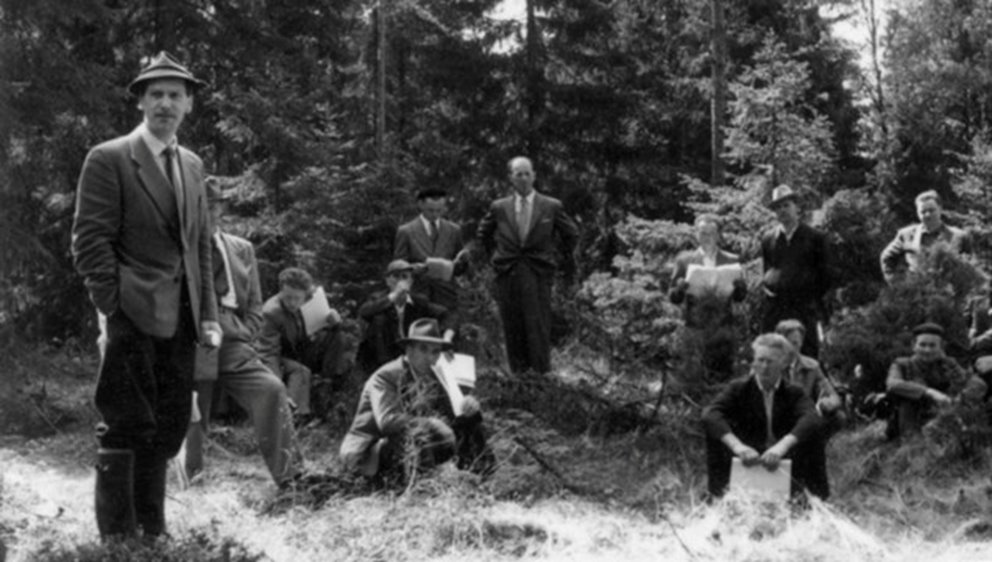Carl Fornling was there from the beginning
On November 1st, 1956, Carl Fornling began his employment as an inspector in the Linneryd forest management area. Almost exactly six decades later, he returned to Linneryd for a historic evening.
When he first arrived, forest owners were on the verge of being placed under guardianship. Gösta Edström, founder of Södra, had successfully convinced the government that there were sufficient timber resources to expand the forest industry in southern Sweden. However, it was far from certain that forest owners would be allowed to control the raw material. There was deep mistrust toward small-scale farming forestry, fueled by criticism from forest companies and labor unions. Farmers’ engagement in forestry was low, partly due to lack of knowledge and uncertainty about what authorities permitted. A mindset began to emerge suggesting that the forest was too important a national resource to be left in the hands of those who happened to own it.
Tired of the Criticism
The forest owners in Linneryd grew weary of the constant criticism. At a farmers’ meeting in spring 1956, Anders Elfström proposed forming a committee to inspire and document forestry activities on local farms. This idea evolved into a forest management area with a hired official tasked with helping farmers become more active in forestry.
The goal was to benefit forest owners by increasing income from the forest while providing authorities with tangible proof of what small-scale forestry could achieve. The idea was pitched to Gösta Edström by the energetic association leader Göte Johansson and Erik Silleström from the Southeast Federation (which later became Södra). Although Silleström had helped establish Sweden’s first forest management area in Hammerdal, Jämtland, that initiative never gained momentum. It was Linneryd that paved the way for the future.
Carl recalls it as an inspiring time filled with pioneering spirit and a group of dedicated forest owners who supported the initiative.
- Without them, it would never have worked. The first challenge was getting enough members to purchase my services. Thanks to Göte Johansson and a few other driving forces, 80 forest owners had joined from the start, which was a solid foundation to build on, Carl explains.
Building the Model
Carl was essentially expected to generate his own salary. Members signed a forestry agreement costing two kronor per hectare annually. For a farmer with 50 hectares, that meant 100 kronor—a significant sum at the time. An additional fee was paid to the inspector.
The usual alternative for forest owners was to hire the county forest ranger for occasional timber marking, which was often cheaper. Carl had to stay ahead and prove his value.
The aim was to increase self-management through advisory services, forest management plans, and shared resources like seedling purchases and rental of common equipment. A major part of the work involved marking trees for harvesting—a natural part of forestry. However, Carl felt it went too far when he was asked to point out every single tree to be removed during early thinnings.
Raising Knowledge and Confidence
- It was time-consuming and felt unnecessary, but the farmers were unsure and afraid of doing something wrong in the eyes of the authorities. We put a lot of effort into increasing their knowledge about the forest, boosting their confidence, and motivating them to take more initiative, Carl Fornling says.
Using forest management plans, they received guidance on what needed to be done. These plans were built from scratch—starting with mapping and boundary setting, followed by envisioning the future forest.
- Almost all forests were uniform. The cautious harvests were usually dimension cuttings, removing only the largest trees, or minor gap cuttings. What remained was mixed forest that often utilized only half its productive capacity. I started with small harvest areas, created stands based on soil conditions, and planned for management ten years ahead, Carl Fornling recounts.
The results were evident—both in the forest and in forest policy. Linneryd inspired many followers, and small-scale forestry earned respect from decision-makers.
From chainsaw to harvester
Thanks to employed inspectors, knowledge about both the forest and new tools has spread more easily. Ulf Olsson worked as a forestry inspector for over 40 years. He began his career immediately after graduation in 1976 and worked within Södra until retirement:
− When I started, you were hired as an area technician and helped with just about anything: marking main forward roads, stick roads, and areas for the different cutters. We also marked all the trees that were to be felled in the thinning. I moved huts and showed harvesting sites. I also visited forest owners to help them with advice, Bucking, and marking. I also helped the buyer and the Harvesting manager with contract writing and payroll administration.
Ulf has seen how work in the forest has changed over the years. We've gone from chainsaws to harvesters and from slide rule to iPad. Over the last 20 years, the ambition regarding nature conservation issues has also increased.
The most enjoyable has been all the meetings with forest owners, and when you notice that they realize the advice they got from me wasn't so bad, maybe even pretty good. All the phone calls home in the evenings and on weekends, worries about road conditions and damage during bad weather—that was the boring part. You were never really off-duty. It got better when we got car phones. Back in the 1980s, it was a big box sitting in the car's rear. Not many forest owners dared to call it, but at least I could call people when I was driving home.
The member should be at the center
Rasmus Olsson, an advisor on Kristianstadslätten, and a former inspector, shares:
-In all our decisions, the member should be at the center. The landowner should be satisfied, which shapes our decisions at every level. My role as an advisor is built on long-term relationships. We don't work with forests but with relationships.
-The idea is that we advisors should be more available for personal meetings, which means we've been relieved of other tasks. A coaching coordinator handles everything that used to pile on top of the inspector's job, like preparing for forestry days and supporting others with administrative tasks. We can focus on personal meetings with our members.
-We advisors are still the hub and need to stay informed and knowledgeable in all parts to interact well with the landowner. To get quicker answers, it's important for members to also use the new forest owner support. There are colleagues who know as much as we do and have access to all systems.


